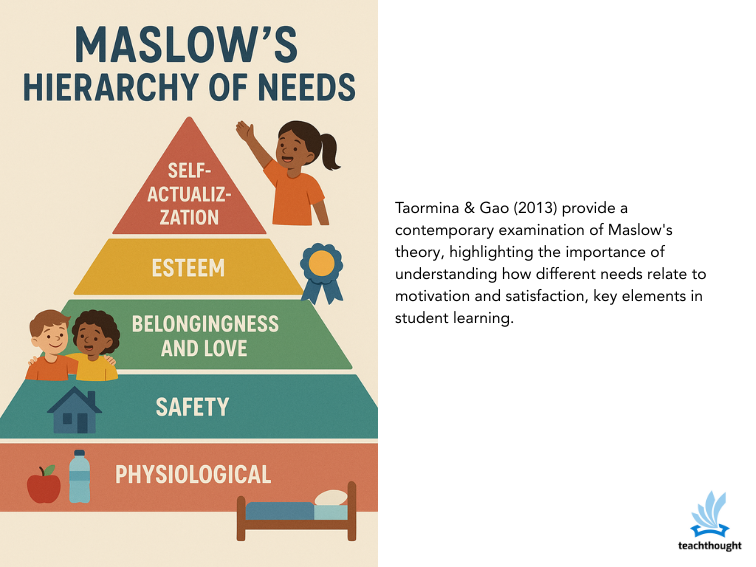Teaching Strategies For Maslow’s Hierarchy Of Needs
by TeachThought Staff
Maslow’s Hierarchy of Needs, developed by psychologist Abraham Maslow in 1943, is a foundational theory in psychology that describes the stages of human needs as a pyramid, with the most basic needs at the bottom and more advanced needs at the top.
Individuals must satisfy lower-level needs before they can adequately focus on higher-level ones.
Let’s synthesize the information about Maslow’s Hierarchy of Needs for your K-12 educator audience, incorporating the research citations you requested.
Understanding and Applying Maslow’s Hierarchy of Needs in the K-12 Classroom
Maslow’s Hierarchy of Needs, developed by psychologist Abraham Maslow in 1943, provides a powerful framework for understanding the fundamental needs that drive human behavior and motivation.
This model, often depicted as a pyramid, suggests that individuals must satisfy lower-level needs before they can adequately focus on higher-level ones. For K-12 educators, understanding this hierarchy is crucial for creating a supportive and effective learning environment where all students can have the best chance to learn and grow.

The Five Levels of Maslow’s Hierarchy and Their Relevance to Students
Physiological Needs: These are the most basic needs for survival. For students, this translates to having their needs for hunger, thirst, rest, warmth, and basic health met. Students who are hungry, tired, or unwell will struggle to concentrate and learn effectively.
For Educators: Be attentive to signs of unmet physiological needs. Provide access to water, allow for movement breaks, and be aware of resources within the school to support students facing these challenges.
Safety Needs: Once physiological needs are met, students need to feel safe and secure, both physically and emotionally. This includes a predictable and orderly school environment, free from threats, as well as a classroom where they feel accepted and respected.
For Educators: Establish clear routines and expectations, create a positive and predictable classroom climate, and address any instances of bullying or harassment promptly.
Love and Belonging Needs: This level involves the need for social connection, acceptance, and feeling part of a group. For students, this means having opportunities to build positive relationships with peers and feeling a sense of community within the classroom and school.
For Educators: Foster a sense of community through collaborative activities, encourage positive interactions, and create an inclusive environment where every student feels valued and like they belong.
See also 50 Of The Best Quotes About Teaching
Esteem Needs: Once students feel a sense of belonging, they need to develop self-esteem and confidence. This includes feeling good about themselves, receiving respect from others, and experiencing a sense of achievement and competence.
For Educators: Provide opportunities for students to experience success, offer specific and positive feedback, celebrate effort and progress, and help students recognize their strengths.
Self-Actualization Needs: This is the highest level and involves realizing one’s full potential, pursuing personal growth, and striving to become the best version of oneself. For students, this can manifest as a desire for creativity, problem-solving, and continuous learning.
For Educators: Encourage students to explore their interests, provide opportunities for creative expression and challenging tasks, and foster a love of learning that supports their individual growth.
Recognizing and Addressing Unmet Needs in the Classroom:
Observing student behaviors can provide valuable clues about their unmet needs. For instance, a student who frequently complains of hunger or fatigue may have unmet physiological needs. A student exhibiting anxiety about changes or seeking constant reassurance might have unmet safety needs. Social isolation or attention-seeking behaviors could indicate a lack of belonging, while low self-confidence or reluctance to try new things might point to unmet esteem needs.
By understanding these potential indicators, teachers can implement practical strategies to create a more need-supportive learning environment. This includes establishing clear routines, fostering positive relationships, providing opportunities for success, and creating an inclusive classroom culture.
The Impact on Learning and Broader School Considerations:
Addressing students’ needs is not just about their well-being; it directly impacts their engagement, motivation, and academic achievement. When students feel safe, connected, and valued, they are more likely to be receptive to learning and reach their full potential. Collaboration with school counselors and other support staff is crucial for addressing more significant or persistent needs. Furthermore, a school-wide commitment to creating a need-supportive environment can have a profound positive impact on the entire student body.
Research Insights
Taormina & Gao (2013) provide a contemporary examination of Maslow’s theory, highlighting the importance of understanding how different needs relate to motivation and satisfaction, key elements in student learning.
McLeod (2023) offers a clear and accessible overview of Maslow’s Hierarchy specifically for an educational context, providing practical examples of how these needs manifest in schools.
Ryan & Deci (2000)’s Self-Determination Theory offers a related and empirically supported perspective, emphasizing the fundamental psychological needs of autonomy, competence, and relatedness, which align with Maslow’s higher-level needs and provide valuable insights into fostering intrinsic motivation in students.
Works Cited
McLeod, S. A. (2023). Maslow’s hierarchy of needs. Simply Psychology. Retrieved from [Insert the actual URL of the Simply Psychology page on Maslow’s Hierarchy of Needs here]
Ryan, R. M., & Deci, E. L. (2000). Self-determination theory and the facilitation of intrinsic motivation, social development, and well-being. American Psychologist, 1 55(1), 68–78.
Taormina, R. J., & Gao, J. H. (2013). Maslow and the motivation hierarchy: Assessing satisfaction of the needs. The American Journal of Psychology, 126(2), 155–177.



